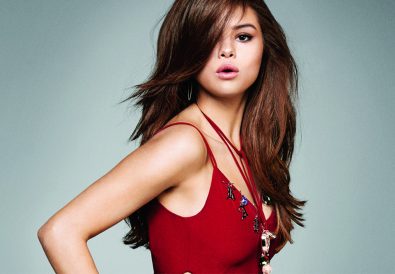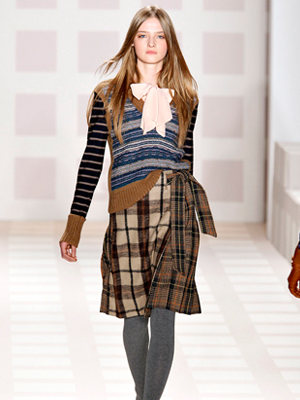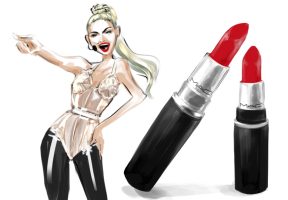By Christopher Turner
On February 11, 2010, the world was shocked by the death of Lee Alexander McQueen, one of the most celebrated fashion designers of our time. McQueen was found dead at his London apartment – he had hanged himself in his wardrobe nine days after the death of his beloved mother, Joyce.
McQueen had a reputation for controversy, especially with his runway presentations, which earned him the titles “enfant terrible” and “the hooligan of English fashion.” Few understood Britain’s most accomplished (and controversial) designer during his lifetime, which is probably why we continue to be captivated by his work. It remains the backbone of the British fashion label that continues to thrive today under the creative direction of Sarah Burton, McQueen’s former right arm. There is, of course, a certain amount of myth associated with the man, his rise to fame and his designs, but ultimately he is most remembered and celebrated for runway collections that showcased designs that were equally beautiful, dark and thought-provoking.
Who was Lee Alexander McQueen the man? The youngest of six children, he was born to Ronald and Joyce McQueen in Lewisham (a borough of London), on March 17, 1969. He left school at 16 to serve an apprenticeship at the Savile Row tailors Anderson and Shephard. After a few years there, he moved to Gieves & Hawkes, another Savile Row house, and later to the theatre costumiers Bermans & Nathans (later known as Angels). At the age of 20, he worked for Japanese avant-garde designer Koji Tatsuno; a year later, he flew to Milan after landing a job as a design assistant to Faenza-born designer Romeo Gigli.
He returned to London, where he completed a master’s degree in fashion design at the prestigious Central Saint Martins College of Art and Design, graduating in 1992. His graduation collection, which was inspired by the tragic stories of Jack The Ripper’s Whitechapel victims, was famously bought in its entirety by fashion icon Isabella Blow, who had worked at Vogue in New York and at Tatler in London before moving to British Vogue. Blow would go on to champion and mentor the young designer and help catapult his career, before her death in May 2007. Ultimately, McQueen’s “Jack The Ripper Stalks His Victims” presentation set the tone for the runway shows that followed throughout his career.
After graduating, he set up his own label under the name Alexander McQueen (after a suggestion from Blow), based in the East End of London. His first professional runway show, his spring/summer 1994 “Nihilism” collection, was presented in October 1993 at the Bluebird Garage in Chelsea during London Fashion Week (although it was not officially part of the fashion calendar).… Audiences were left shocked.
It wouldn’t be the last time.
Over the course of his 18-year career, the designer’s presentations for both his eponymous label and French luxury fashion house Givenchy (where he served as creative director from 1996 to 2001) were the stuff of legend, shocking and enthralling audiences.
On the anniversary of his death, we’ve rounded up the 10 most iconic runway collections of McQueen’s extraordinary career to celebrate his genius.
![]()
HIGHLAND RAPE
Fall/Winter 1995-96
Alexander McQueen’s fall/winter 1995-96 runway show – his first show to officially be on the fashion calendar – was presented on March 3, 1995, inside an official British Fashion Council tent outside the Natural History Museum in London’s South Kensington neighbourhood. The show introduced the designer’s trademark bumster pants and his fierce national pride: he used his own family’s tartan for many pieces, something he would continue to do in later shows, including 1998’s “Joan” and 2006’s “The Widows of Culloden.”
But that isn’t why it’s remembered. McQueen’s was the last presentation of the week and there was a ton of excitement…until fashion watchers saw the program: a single photocopied sheet with the show’s title, “Highland Rape.”
It was shocking. Models walked the runway with bloodied bodies looking bruised and posing in a distraught way wearing torn garments, like a grimy-looking lace dress and a green calf-length dress slit to expose one breast.
The show was about the Highland Clearances and England’s violation of Scotland, not the brutalization of women – but journalists and reporters misunderstood the historical reference and portrayed the show as one of misogyny, with global headlines proclaiming the show was a glorification of rape.
In retrospect, “Highland Rape” is considered to be the launching point of McQueen’s fame, and has been credited with leading to his appointment as head designer at Givenchy in 1996.
![]()
LA POUPÉE
Spring/Summer 1997
McQueen continued to attract criticisms of misogyny with his spring/summer 1997 collection. Staged at London’s Royal Horticultural Halls on September 18, 1996, his “La Poupée” (or The Doll) runway collection was one of the most provocative fashion shows of the ’90s. Inside the venue, at the foot of a grand set of stairs, McQueen’s team constructed a 50-foot wading pool, three inches deep, that served as the runway. Models appeared to be walking on the water thanks to the clear platform shoes they all wore.
Inspired by German artist Hans Bellmer, who rearranged toy dolls to create surreally strange works of art, McQueen sent models down the runway in distorted styles: low-cut pants, macabre shift dresses, tailored jackets, shot-silk suits and fringe skirts. Creations by Shaun Leane and Philip Treacy accompanied McQueen’s work.
Many pieces purposely distorted the model’s body, the most obvious example being one worn by Black model Debra Shaw (above left). Many in the audience were aghast when Shaw, her arms connected to her thighs by a metal frame, made her way down the stairs into the water before moving in a slow dance, gesturing with her hands, her beaded fringe dress swaying with her movements. The press immediately made the assumption that the look was honouring slavery. He wasn’t.
![]()
IT’S A JUNGLE OUT THERE
Fall/Winter 1997-98
McQueen won his first British Designer of the Year award in 1996, and in that same year he was appointed head designer at Givenchy, succeeding John Galliano (who had moved to Dior). He was flying high.
His first Givenchy haute couture collection, which McQueen presented in January 1997, had disappointing reviews. But there was no time to dwell on that: he had to head back to London to work on the upcoming show for his own label. In February 1997, he staged his fall/winter 1997-98 runway presentation for his eponymous label in a glass-roofed produce warehouse near London Bridge.
The clothes that hit the runway for “It’s A Jungle Out There” were inspired by nature, but the title was a response to the criticism he had received with his Givenchy showing. According to McQueen, inspiration came after he watched a nature documentary on the brutality of the African savannah and gazelles being hunted by lions. “That’s me! Someone’s chasing me all the time, and if I’m caught, they’ll pull me down. Fashion is a jungle full of nasty, bitchy hyenas.”
Models strutted down the runway with teased manes and eye makeup to resemble gazelles. Clothes were animalistic in nature, and most models were accessorized with animal skins and horns. One strong-shouldered jacket (above right) featured an image of an Old Master painting, while others were embroidered with roses.
The London show restored McQueen’s reputation, and he went on to produce a number of well-received collections for his own label and Givenchy. He left Givenchy in March 2001 after his contract ended, with McQueen arguing that the company had started to “constrain” his creativity.
![]()
UNTITLED
Spring/Summer 1998
The biggest controversy surrounding McQueen’s spring/summer 1998 runway presentation was the name. The original title had been “The Golden Shower,” but when American Express (which was about to launch a new gold credit card and was sponsoring McQueen’s pricey production) realized the implications of the name of the show they were investing big bucks in, they insisted that McQueen change it. Hesitantly (or defiantly), he simply named the collection “Untitled.”
Shown on September 28, 1997, in the Gatliff Road warehouse, a rundown former bus depot near London’s Victoria Station, the show featured a runway made of water-filled acrylic tanks, under yellow lights, and a soundtrack of thunder crashes. The models wore tight snakeskin dresses and tailored suits that were precisely cut. For the finale? Models wore all white and were treated to a shower that ensured their mascara ran down their faces and their all-white clothes were completely see-through.
![]()
JOAN
Fall/Winter 1998-99
Inspired by the murders of Catholic martyr Joan of Arc and of the Romanov family, McQueen’s fall/winter 1998 show was dark and sinister. “Joan” took place in February 1998 inside a London storage building, with an elevated runway inside. The show was dedicated to McQueen’s friend Annabelle Neilson. And the theme? Clothes as armour and clothes that look like armour.
Models with red contact lenses and severe hairstyles walked the runway in medieval-inspired pieces, many of them made of chain mail (above right). There were also elegant dresses in grey, silk harem pants and sharp tailored suits.
Having already explored the element of water, the designer moved on to fire, closing the runway spectacle with his model wearing a glittering red dress (above left), her face and neck completely covered with a matching hood, trapped in a ring of flames.
A medieval army meets London punk.
![]()
No. 13
Spring/Summer 1999
McQueen’s “No. 13” runway presentation took place in a warehouse in central London, not far from Victoria Station, on September 27, 1998. The inspiration for his spring/summer 1999 show – his 13th – was primarily Arts and Crafts, a design movement that was popular between 1860 and 1910. Another inspiration: Aimee Mullins, a Paralympic athlete and model whose legs were amputated below the knee and as a result wore prosthetics. Mullins opened the show wearing prosthetic legs that had been designed by McQueen to look like boots and were handcrafted over five weeks by the Dorset Orthopedic Company.
The closing of “No. 13” is one of the most memorable of McQueen’s career. Model Shalom Harlow, dressed in a perfectly white tulle dress fastened with a thick leather belt, became a human canvas. As she stood in a circle cut into the floor in the centre of the stage, robotic arms sprayed paint on her. Harlow held her head in dismay as the robots sprayed her with black and acid yellow paint while the crowd applauded. The designer later explained that this was his way to show the computerized production processes in the fashion industry.
![]()
VOSS
Spring/Summer 2001
At the turn of the millennium, McQueen’s shows had become increasingly extravagant performance artworks, and “Voss,” his spring/summer 2001 presentation, was no different. Presented in the Gatliff Road Warehouse on September 26, 2000, the show was named after a small Norwegian town known for its splendorous nature, and was inspired by both Victorian depictions of madness and New Mexico-based photographer Joel-Peter Witkin’s Sanitarium (1983), which pictures a large naked woman reclining. While these themes were definitely at play within the show, McQueen’s spiralling mental health and the “dark side” of fashion were very present.
Nature was reflected in the natural material used in some of his clothes such as ostrich feathers, but more unusual were outfits made out of razor clam and mussel shells.
“Voss” unofficially holds the title as McQueen’s most disturbing runway show. The audience sat around a glass box showing a padded room (mimicking the walls of a mental asylum), inside which models were frantically running around, with another dirty glass box in the centre, which was filled with butterflies and a large naked woman attached to a medical machine. McQueen had brought Witkin’s photograph to life.
At the end, the applause was thunderous and critics were wowed. The consensus: it was like watching a gorgeous horror film.
![]()
WIDOWS OF CULLODEN
Fall/Winter 2006-07
McQueen’s “Widows of Culloden” runway presentation was on March 3, 2006, at the Palais Omnisports de Paris-Bercy in Paris, about two miles from the centre of the city. The show was dedicated to his famously eccentric friend and early patron, Isabella Blow. (Just over a year later, on May 6, 2007, after several suicide attempts, Blow drank paraquat weed killer; she died in hospital the following day.)
The show marked a return to theatricality for McQueen, whose shows in the preceding two seasons had been comparatively conventional. “Widows” was inspired by his Scottish ancestry, and is regarded as one of his most autobiographical collections. It was also inspired by his mother, a nature lover who had slowly opened McQueen’s eyes to observe and appreciate the world around him.
The clothes in the show were spectacular: romantic looks, many featuring layers of torn chiffon with smart tailoring, nipped-in waists and padded hips. A look worn by model Raquel Zimmerman (above left) – a full-length ivory gown in silk tulle and lace with an antlered headdress – was particularly impactful.
But the moment that made this runway so memorable came in the final moments, when a hologram of Kate Moss appeared on a glowing pyramid as the finale of the show (above right). It was meant as a gesture of support from a close friend; Moss had been missing from the runway since her 2005 drug scandal.
![]()
THE HORN OF PLENTY
Fall/Winter 2009
In 2009, when a global recession resulted in a widespread economic crisis, McQueen took the opportunity to play around with the concept of greed and excess through his fall/winter 2009 collection. “The Horn Of Plenty” collection was shown at the Palais Omnisports de Paris-Bercy on a stage filled with a huge pile of tires, old computer keyboards, burned-out televisions, uncoiling hoses, car parts, antlers and broken chairs. Cracked mirror tiles made up the surface of the catwalk.
McQueen presented his love and hate of couture fashion on March 9, 2009, and shocked fashion watchers with his creations of extravagant proportions made from unusual materials. There were those who found his presentation painfully theatrical and misogynistic (thanks to the sex-doll lips that appeared on the models), but the general consensus was that the clothes were outstanding. There were parodies of Christian Dior’s famous houndstooth New Look and Chanel’s iconic tweed suits, swag-sided coats made of trash bags and accessorized with aluminum cans, and elaborate ball gowns made out of plastic bags. Then there were the bird-inspired designs: the collection’s closing looks were two over-the-top feathered concoctions: one in white, with the collar reaching high over the model’s shoulders, and the other in sleek black, with wings bursting out the sides.
![]()
PLATO’S ATLANTIS
Spring/Summer 2010
McQueen’s final runway before his death became known as the greatest collection of his career. For “Plato’s Atlantis,” the designer returned to one of his recurring themes: the theme of nature. The title of the collection was inspired by a fictional island created by Greek philosopher Plato. It was described as an island that was being submerged by the ocean, forcing the human species to adapt and evolve into amphibians. McQueen explained that he saw Atlantis as a place “where people find sanctuary in bad times.”
The show began with a video of model Raquel Zimmerman (also seen in “The Widows of Culloden”) lying naked on sand with snakes on her body. The clothes echoed Plato’s envisaged future where humans are forced to evolve from living on land to living in water in order to survive. The colour scheme changed during the show from green and brown (representing land) to blue and aqua (ocean). The prints also shifted, from reptilian to prints of water creatures such as jellyfish and stingrays.
There were a few elements that made this runway show truly iconic– besides the fact that it was McQueen’s last ever complete production. For one thing, it became the first-ever live-streamed fashion show on October 6, 2009, when it was hosted on Nick Knight’s Showstudio platform. The stream was revolutionary in itself, but then Lady Gaga announced on Twitter that her latest song, “Bad Romance,” would debut during the runway show. Millions of people worldwide logged on to watch, causing the site to crash midway through the show. (Lady Gaga’s role in making “Plato’s Atlantis” a bona fide pop culture moment outside the realm of fashion cannot be understated.)
And then there were the shoes. It’s impossible to write of “Plato’s Atlantis” and not talk about the Armadillo shoes, which mimicked the feet of humans morphed into animalistic forms. Never in fashion has a shoe eclipsed the rest of a collection the way those 12-inch heels did. They took cues from nature while disfiguring the human body, they were theatrical, they were completely fresh and, above all, they were grotesque. (Models Abbey Lee Kershaw, Natasha Poly and Sasha Pivovarova allegedly backed out of the show due to safety concerns over wearing the shoes.)
Ultimately, the shoes caused a sensation…just as the designer had been doing throughout his entire career.











